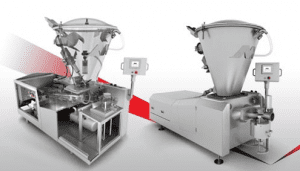 Brad Willsey, director of service at Marlen International, the Kansas-based food processing equipment manufacturer, runs a team of seven service techs who keep tabs on Marlen’s industrial sausage grinders, meat dicers and slicers, packers and other machinery at dozens of customer locations in the U.S. and abroad. Willsey talked to The SmartVan about the complexities of the operation, and how new tools and apps are — finally — changing a tough business.
Brad Willsey, director of service at Marlen International, the Kansas-based food processing equipment manufacturer, runs a team of seven service techs who keep tabs on Marlen’s industrial sausage grinders, meat dicers and slicers, packers and other machinery at dozens of customer locations in the U.S. and abroad. Willsey talked to The SmartVan about the complexities of the operation, and how new tools and apps are — finally — changing a tough business.
What are some of the biggest challenges you’ve had to address on the job?
Keeping track of everything. When I was promoted and we were looking at the scheduling and dispatching of technicians – and this is still an ongoing issue – tracking the number of days the technicians are out on the job and how much time they’re spending on what types of service jobs is the biggest challenge.
Also, coordinating communications with and between the sales and service departments as it relates to the machinery. Getting that communication and visibility in place was something we struggled with until we starting using programs like Salesforce and ServiceMax. (Disclosure: ServiceMax is a sponsor of The SmartVan.)
How were you organizing your operations — pencil and paper? Spreadsheets?
When I first started 15 years ago, we didn’t even have cell phones. Everything was handwritten. Techs used to have to call and check in once they got to the airport. Rerouting a technician was extremely troublesome. Even today, when scheduling the technicians, it was and still is the Excel spreadsheet. We’re manually tabulating and plugging in the numbers. Whether it’s for startup or warranty work, paid service, a courtesy visit or a demonstration, we’re manually keeping track of all those hours.
We want to be able to capture the days that our technicians are out there doing those different types of jobs. Every day that a tech is out doing a warranty job, he’s unavailable for doing a paid service call. So we want to track how many days he’s doing warranty. Say this month we have 10 warranty days and last month we only had six. What’s happened? Tracking that information allows us to dig into what those items were that required warranty work so that we can prevent those types of issues in the first place. There’s just nowhere to plug in how many days they’re doing what. We’re keeping track but we’re doing it manually.
And that data is something you want to be able to share?
Yes, we’re gathering all that data but someone has to plug it all into an Excel spreadsheet. It’s never fully complete all at the same time, so there’s always a lag.
What are the new ways you’re getting valuable information into the hands of your service techs?
What we’re seeing is that all this tracking adds value for the customer. When the customer calls up and their machinery is down, it may cost them $20 to $45 per minute depending on how many pounds per hour they produce and how large the operation is. If you’re five hours away, they’re down until you get a tech there. So getting them up and running as fast as possible is exactly what we want to do.
If you can make an adjustment over the phone and not have to fly a tech out, then we’re saving our customers a lot of money. So tracking that downtime savings is certainly something of benefit to report back to the customer. Being able to pull those reports quickly is very beneficial.
When we went over to ServiceMax [a suite of cloud-based apps for field-service management] every vendor is tagged with a case number. If it’s a telephone repair that we fix, the program prompts us to plug in a solution when we close the case, provided there’s not already an existing solution. You can then search for a solution as you’re talking to the customer. If it already exists, great. If it’s a new solution, you can publish it so that it’s available for the next technician.
How has this sharing capability boosted efficiency?
If you have someone who is a resident expert and he’s out of the office, you don’t have him to draw on immediately, so how do you get a quick answer to your customer? You plug into that shared knowledge that’s available at your fingertips.
How do you see technology fitting in and influencing different types of companies like yours?
Just having smaller pieces of hardware to carry around makes a difference. Any pounds that a technician can shed while traveling is always a bonus.

Share this: